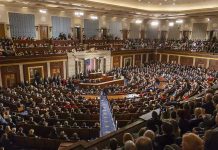
Federal Workers Face Ultimatum: Resign or Accept Trump’s New Rules.
Key Takeaways
- Trump administration offers 2.3 million federal employees resignation with 8 months pay or new work conditions
- Elon Musk leads Department of Government Efficiency, aims to save $4 billion daily by 2026
- 20,000 to 40,000 workers have accepted resignation offer, with more expected before deadline
- AFGE union sues Trump administration over legality of buyout program
- Nationwide protests erupt against Trump’s federal workforce reforms
Trump’s Drastic Measures to Reshape Federal Workforce
President Donald Trump has launched an aggressive campaign to drastically reduce the size of the federal government, giving 2.3 million employees an ultimatum: resign with eight months of pay and benefits or accept new work conditions. This move, part of Trump’s broader strategy to streamline bureaucracy and replace perceived hostile elements with loyalists, has sent shockwaves through government agencies nationwide.
The voluntary resignation program, reminiscent of Elon Musk’s approach at Twitter where he downsized the workforce by 80%, has already seen between 20,000 to 40,000 federal workers opt in. With the deadline looming, agency management is holding last-minute meetings to inform employees about their options, reflecting the urgency of the administration’s plans.
(1/4) 𝐓𝐡𝐞 𝐑𝐮𝐥𝐞 𝐨𝐟 𝐋𝐚𝐰, 𝐄𝐫𝐨𝐝𝐢𝐧𝐠 𝐈𝐧𝐬𝐭𝐢𝐭𝐮𝐭𝐢𝐨𝐧𝐬, 𝐚𝐧𝐝 𝐭𝐡𝐞 𝐆𝐥𝐨𝐛𝐚𝐥 𝐏𝐨𝐰𝐞𝐫 𝐒𝐡𝐢𝐟𝐭
Recent actions taken by the Trump administration — including the “Fork in the Road” email pressuring federal employees to resign, the attempted… pic.twitter.com/JSbVQcH3L2
— Jimmy D, life curator (@th3donut) February 4, 2025
Musk’s Role in Government Efficiency
At the helm of these sweeping changes is Elon Musk, leading the newly formed Department of Government Efficiency. Musk’s ambitious goal is to save $4 billion daily by fiscal year 2026, a target that has raised eyebrows and concerns across Washington. His team has gained unprecedented access to federal IT infrastructure, including personal data of government employees, raising privacy concerns among critics.
“Everybody’s replaceable, and we’ll get very good people to replace them if it turns out to be more than we thought.” – Donald Trump
This cavalier attitude towards the federal workforce has sparked outrage among employees and union representatives. The American Federation of Government Employees (AFGE) has filed a lawsuit against the Trump administration, questioning the legality of the buyout program.
Nationwide Protests and Political Backlash
The reforms have ignited nationwide protests against the president, with thousands participating across the country. Critics argue that this massive reshaping of the federal workforce could lead to a brain drain and compromise the government’s ability to function effectively.
“Don’t be fooled. He’s tricked hundreds of people with that offer. If you accept that offer and resign, he’ll stiff you just like he stiffed the contractors.” – U.S. Sen. Tim Kaine
However, leading Republicans, including House Speaker Mike Johnson, have thrown their support behind Trump’s efforts to reduce the size of the federal government. This political divide underscores the contentious nature of these reforms and their potential long-term impact on the structure of the U.S. government.
Musk’s Focus on Modernization and Efficiency
While the workforce reduction has dominated headlines, Musk’s team is also pushing for modernization in key areas. Plans to upgrade the nation’s air traffic control system for safety have been announced, coinciding with an investigation into a recent crash involving an Army Black Hawk helicopter and an American Airlines jet.
“make rapid safety upgrades” – Mr. Musk
Additionally, Musk’s team has accessed NOAA’s computer systems to identify programs related to diversity policies, which the Trump administration aims to eliminate. This move aligns with the broader goal of ending diversity initiatives and reinstating “schedule F” hiring classifications, further cementing the administration’s conservative approach to government operations.
— @amuse (@amuse) November 11, 2024
Uncertain Future for Federal Employees
As the deadline approaches, federal employees face a difficult decision. The annual attrition rate among federal employees is about 6%, suggesting some may have planned to leave regardless. However, the scale and speed of these changes have left many feeling pressured and uncertain about their future in government service.
With the budget funding the federal government set to expire in March, doubts have been raised about the guarantee of eight months of pay for those who choose to resign. This uncertainty adds another layer of complexity to an already challenging situation for federal workers across the nation.
As the Trump administration pushes forward with its ambitious plans to reshape the federal workforce, the long-term implications of these sweeping changes remain to be seen. What is clear, however, is that the landscape of government employment in the United States is undergoing a transformation unlike any seen in recent history.
Sources:
- ‘I’m in limbo’: Fear and uncertainty in federal workforce as Trump deadline arrives
- Tens of thousands of federal workers accept Trump resignation offer
- Trump Administration Deepens Pressure on Federal Workers to Resign – The New York Times












